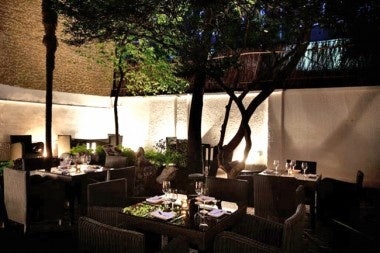"Never Once Have I Said I’m Stepping In And Trying To Cook Shanghainese Food – That’d Be Suicide"#

David Laris (Image: Shanghai TALK)
part one#
of our two-part interview with the Shanghai-based, Greek-Australian chef and restaurateur David Laris, we discussed the evolution of Shanghai's still-young fine dining scene, the changing tastes of Shanghainese diners, and the replacement of free-spending "expat-package" Western diners in the city by upwardly mobile locals. In part two, we cover Laris's status as a "target" among Shanghai's young chefs, his preparation for the entrance of the Gordon Ramsays of the global culinary world into the city, his love for bold design, and the upcoming launch of his first Chinese restaurant, Le Sheng (乐笙).
Jing Daily (JD): Design is a major part of what you do, in the food and the venues. Has that always been a main focus of yours, or did it just click with you at some point?#
David Laris (DL)#
: I grew up in a kind of working-class family, so when it came down to aesthetics, the idea of picking up a design magazine was foreign language to me. But I always gravitated towards cool design, and I got lucky working initially with people like Brian Williams at the Mandarin Macau. I got to see how design could affect mood, and that evolved when I got to work with Terrance Conran and Michael Graves. Then I got to become genuinely interested in the intellectual side of it, the beauty of it that impacts us as people, and once that door’s opened, you start to see things that people who perhaps aren't passionate about it don’t. And that does, I think, translate to me trying to develop moods, based on the budget I have to work with.
I start with concept first, and then I bring in design as phase two, and I think sometimes people do it the other way around. I don’t believe in that. I believe concept has to be at the beginning, and then the design should live the concept. And hopefully we get it right and the aesthetic does match the experience overall, and it does set the tone for your mood. But I do get my hands dirty sometimes, much to the annoyance of designers, though most designers have worked with me again, like Thomas [Dariel of Lime388] (Jing Daily interview).
JD: That’s one thing, I think there's a real visual identity in each of these places, and you don’t see that as often in Shanghai as you should.#
DL#
: Hopefully we’ll see it more, and I am seeing more of it, because it really stands out. And I’m hoping that becomes the city. If everyone could start doing that, we’re gonna have a great industry here. And as much as I like to win, I like to have good competition. It propels us forward and keeps us awake.
JD: You mentioned getting your hands dirty. Now that you’ve got so many projects going at once, does it leave you any time for...#
DL:#
Cooking? (laughs)
JD: Yeah.#
DL#
: It does, actually, absolutely. There was a phase when we pushed very hard forward, where it left me little time in the kitchen, but the strategy always was for me to go back to the kitchen when I got things designed. So it's been a process. We don’t open a place until we’ve gone through everything with the chefs, and multiple tastings and refinements and platings. Then, if I’ve got a good guy in place, like Lex [Hauser] at the Purple Onion who gets it, I don't feel I have to go in and step on his toes. There are other chefs in the group I spend a lot more time in the kitchen with. At the moment, I’m spending probably as much as 70 percent of my time in the kitchen. If you’d asked me six months ago, it probably would’ve been 50, but now it’s getting closer to 70, which is a good healthy spot to be. I cook at almost every single 12 Chairs seating, and that’s a full-on process of getting ready and serving.
We’re just about to revamp the menus for all of the Fat Olives, because the team’s grown to the point where I can push them to the next level. That’s one thing you have to be clever about when you’re doing these kinds of things. You bring the team and the market up with you. For the next week, I’ll be in the Fat Olive kitchen developing new dishes. Because my catchphrase internally for this is, I want to make "Greek Chic." So the menu, I think, is great, but I believe it can be even more. I don’t want to take away the core, like the family-style dining, which Chinese customers love, it’s about subtle growth. It should never stand still.

JD: Do you ever worry you’re getting too big, and at some point, as a figure in Shanghai, you’ll become almost like a target?#
DL#
: I already am a target! (laughs)
JD: True, well, I guess it’s just one of those things I’m curious about, in terms of dealing with that.#
DL#
: Not a lot of people have ever approached that question, but it’s an excellent question. And it's something very close to me, because I look at myself and I’m just a super-ambitious guy. I want to do great things and be appreciated for it – that’s my starting point. And in the beginning, when you’re the underdog, everybody roots for you. You kind of break ground, you start defining the market in your own way, and all of a sudden people do start to have a bit of a go. You become a target.
And initially it kind of took me aback, because I didn’t see it coming and didn’t expect it. In my mind, I’m just a guy who’s working really hard to do cool things and hire a lot of people and help the industry. So it initially hurt a little bit, and I was reading blogs and things, and a lot of it was positive, but for others I just thought (grimaces), "Hey, this guy doesn’t know me!" But eventually you just realize it’s all part of having a public profile, so it is what it is.
But in terms of getting too big, I don’t think so, because you look at the global market, and I’m not even a fraction of what the big guys are. You look at Jean-Georges, you look at Gordon Ramsay, these guys are monsters! I’m an ant in comparison to those guys, in terms of what they’ve been able to achieve globally. The issue is, really, that this market has to grow more, and I think it’s more of a case that I’ve been pushing, and I work a lot, and am constantly focused on where I’m trying to get to as a company and as a person, and I’m waiting for more competition to come and take some of the heat off of me. And that’s why I love having guys like Paul Pairet [of Mr. & Mrs. Bund], who I think is insanely good, it’s good to have these chaps about, because if there’s more of us at a certain level, it’s only good for the market itself and good for us as individuals.
But I don’t worry about getting too big. I’d like to get much bigger, but I’d like others around me getting bigger as well.
JD: It seems like there have been quite a few younger chefs coming in over the past few years, and it seems that there’s a bit more of a community now.#
DL#
: There is. Probably before, you wouldn’t have called it a community, it'd be more of a collective -- people huddled together because it’s a difficult environment. But now there’s really much more of an industry. I’d like to see some of the guys who do have the potential in this industry to take it a bit more seriously and adopt that sort of global professionalism that we require. We can’t be loose about it here, because international players will [eventually] come in with that organized structure and some of these guys are going to get their asses kicked. And I want to be ready for when that does happen, so I don’t just get pushed down, so I can compete with these guys toe-to-toe. That’s the kind of market I want to be in. I want to stand against the best and see where I come out.
JD: To backtrack a little bit, you were talking about the global side. Now that you’re positioned here, are you hoping to go to Hong Kong or somewhere else?#
DL#
: Yeah. There’s two parts, the way I look at it. Some of [my] brands that can be replicated, like the Fat Olive, the Funky Chicken, can be taken to other cities. I’m hoping they can move out to the second-tier [markets]. Whether I’m the guy driving it or there are other people in my company who are taking that onboard, we’ll see. I’d love to see that happen.
Then, on the other side, I’d love to be in Hong Kong, both with Laris, the major restaurant brand -- I’d love to see that in Hong Kong -- and maybe a couple of the other brands as well. What I want to focus on is getting the established company to a point where there are people who can drive forward all the other brands, with my guidance in terms of standards of quality and food and so on, but then I can focus really on the high-end side of the cooking restaurants and personally run a couple of the restaurants. But be in the kitchen all the time. And I’d love for one of them to be in Hong Kong. I think it’s a great bridge. I mean, life’s too short. The idea of being somewhere like New York is also exciting, but whether or not the wind will blow that way, I don’t know. Or, of course, Sydney, because it’s home. The presence and profile of Sydney over the years has grown and surprised me, because I didn’t look for it to happen.

JD: Looking at the idea of challenges, I know you’re getting ready to open your first Chinese restaurant in October. Can you say something about that project?#
DL#
: Yeah, I saw something online that said something about [me] “treading on thin ice,” on one of the blogs or websites here, and I thought it was fantastic. And no doubt, when we set about to stylize a Shanghai restaurant, we knew people were gonna say something. But the honest truth is, when people see it, it’s a small, boutique-style Shanghainese restaurant, it’s designed by Andy Hall, who’s done quite a bit of work around China. It’s not going to be gaudy, overtly what you’d expect from a Chinese concept. More of that fact that you can do Chinese and it doesn’t have to be designed in a specific way that it says it’s a Chinese restaurant, although there will be a lot of Chinese accents. It’s a contemporary, cool sort of space. I’m hiring a great Shanghainese chef who’ll lead the culinary.
Never once have I said I’m stepping in and trying to cook Shanghainese food – that’d be suicide. I might touch Thai and I might do other things, but I’m never gonna touch Shanghainese cuisine in Shanghai. I’ve taken it on with a partner who came to me and said, “I want to do this, I want you to stylize it, and this is what I want.” I took his initial thoughts and said, “this is the concept.” And I look at the ingredients we source, I look at more sustainable products. There’s a fine line, in my opinion, between the garnishing process in Chinese cuisine when it can be street and great, or it can be overdone, you know, and carved carrots. So can we work together with this team and let them be the ones who are leading it, but can we give them some guidance.
It’s a very delicate and challenging process, but in the end it has that Chinese authenticity to it. The guy who’s done the graphics for us is a Chinese artist, all the marketing and online stuff is done by a Chinese team, I’m doing almost all of this project through a translator, because I don’t want it to sting of “Western.” I want it to sting of “contemporary.” Contemporary China, touching something. And no matter what you want to say, contemporary China has had influences in a global sense, they’ve taken the best of what they’ve seen and they’ve added some of their newer things. We’ve got a Chinese GM, we’ve got a tea [master], who has his own tea emporium and is going to create a tea menu, so it’s intelligent, I think, in the way we’ve gone about it.
On the surface, it looks like a Shanghainese restaurant, but I hope that people see that it’s a great place to come and try authentic Shanghainese cuisine in a nice contemporary environment. And if it works, my partner is keen to then go on to Hong Kong, or even take it to London, so who knows? He’s asking, “Can I take Shanghainese to London, in a way that it’ll be globally received?” So that’s really our challenge, and really at the core of what we’re trying to achieve. And Anfu Lu, if you’re going to pick a kind of neighborhood restaurant, Anfu Lu has to be the street.
JD: So one final, big question: Beijing versus Shanghai?#
DL#
: You know, I would’ve said up until about a year ago, in terms of dining "eclecticness" and the industry itself, it was Shanghai. I mean, there was no question. And I think pre-the Opposite House, there really wasn’t a lot of that [high-end] level aside from the typical five-star hotel restaurants, which were all empty. But the last 12 months in particular, I believe Beijing will start to give Shanghai a serious run for its money. It’s not quite there yet in terms of variety or industry, but there are some things popping up which are definitely going to be increasingly pushing it forward. And they’re inherently different, that’s what’s so interesting about them.
It’s like comparing New York and L.A., as far as dining places go. They’re both going to be very serious food cities. There’ll be a different kind of depth, as far as Beijing, I think there’ll be more intelligence around local cuisines, and more design intent than perhaps I’m seeing here in Shanghai. When it comes to Western, Shanghai’s still (holds hand up) here, but others are nipping at its heels. It’s all about Beijing itself creating its own concepts and not becoming just the next stop for guys who created their concepts in Shanghai. I’m excited about Beijing, I love the city. I think it’s got a lot of great things going for it. And as a dining city, recently I’ve not been bored.